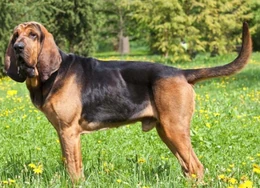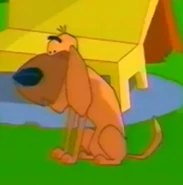
Male Bloodhound
With his sunken eyes, deeply furrowed face and loose jowls, the Bloodhound resembles a person in dire need of a facelift. The sad-eyed appearance is misleading, however. This is an affectionate dog with a sense of humor and a strong character, traits balanced by a reserved and sensitive nature. He takes his name from his long lineage as a “blooded” hound, one kept by aristocrats for centuries and prized for his ability to trail game and people. Today he is renowned for his man-trailing ability and under certain circumstances his “testimony” is accepted in court.
When it comes to living with a Bloodhound, the house-proud need not apply. Noble he may be, but the Bloodhound is also big -- weighing from 80 to 115 pounds -- and odorous. His capacity for producing drool is matched by few other breeds, and when he shakes his massive head, slobber goes flying: onto walls, furniture and clothing. In accordance with Murphy’s Law, this is most likely to occur just after you have finished cleaning your home or have just gotten dressed for a night on the town.
While you might think of him as an outdoor dog, nothing could be farther from the truth. Bloodhounds love their people, especially children, and will pine without human companionship. They should certainly have access to a securely fenced yard, but when the family is home, the Bloodhound should be with them.
Bloodhounds have short, easy-care coats in black and tan, liver and tan, or red and need only a weekly brushing or wipe down. That’s where the easy part stops. The wrinkles must be cleaned daily and kept dry to prevent infection. Be prepared to wash the face thoroughly after every meal and wipe the mouth after your Bloodhound drinks water—before he shakes his head and slings water and drool everywhere. Be aware as well that the Bloodhound has what can best be described as a musty odor. You can’t wash it away or disguise it, so be prepared to live with it and love it.
History[]
Dogs like the Bloodhound have been in existence for centuries, used by noblemen to track game in the ritual of the hunt. The dogs take their name from the care taken in recording their ancestry, or bloodlines, so they were “blooded” hounds. Today’s Bloodhound descends from the St. Hubert hound, created in eighth century France to follow difficult trails in search of treacherous game such as wild boar. William the Conqueror brought St. Hubert hounds with him when he conquered England in 1066, and it was there that the Bloodhound eventually blossomed, some 800 years later.
The Victorians were famous for creating dog breeds as we know them today — previously there had been no breed standards and rarely any record keeping of bloodlines. The rise of dog shows and a widespread interest in the keeping of fine or rare animals helped to save many breeds from extinction. The Bloodhound was one of them. His ability as a mantrailer, and the patronage of Queen Victoria, herself a noted dog lover, saved him from fading into oblivion. Man-trailing with Bloodhounds became a popular leisure activity, and it didn’t take long before the police recognized the Bloodhound’s usefulness in tracking down criminals. These days, the Bloodhound is still a favored member of many law enforcement teams. His testimony is even accepted in court.
Temperament and Personality[]
The Bloodhound is calm by nature, but by no means lazy. Forget that image of the sleepy hound on the front porch. This is a working dog capable of trailing a scent for hours or even days.
Life with a Bloodhound puppy can best be described as bedlam. Bloodhounds are master chewers and can easily destroy walls, doors and furniture if left unchecked. They will also eat anything in the hope that it is food: rocks, socks, toys, plastic wrap, kitchen towels, batteries, cell phones — the list could go on and on. It’s not unusual for this breed to require multiple veterinary visits or even surgeries to deal with intestinal blockages. Constant supervision and a good crate are essential to raising a Bloodhound puppy.
A bored Bloodhound with energy to burn will create his own entertainment. He’s a champion hole digger and can remodel your lawn in no time flat. Given the slightest opportunity, he will escape your yard to follow an intriguing scent and wander for miles before realizing that home is nowhere to be found. He’s not able to backtrack, so it’s best to prevent breakouts by enclosing your yard as thoroughly as if it were Alcatraz or Fort Knox.
The Bloodhound is renowned for his gentle nature, but beneath that placid exterior lies a tough, stubborn, independent hound. Training a Bloodhound requires skill, cunning and what some might call bribery. Positive reinforcement, particularly with food rewards, is the way to win a Bloodhound’s heart and mind. Force, on the other hand, will get you nowhere. When it is employed, the Bloodhound will simply don the mantle of passive resistance and refuse to do anything. For best results, begin training your Bloodhound when he is young and still somewhat malleable.
To fulfill the Bloodhound’s need to work, channel his amazing scenting ability with long, slow walks or hikes, permitting him to sniff out and explore trails. If possible, teach him to mantrail he’s born to it, after all and get involved in your local search and rescue organization. If nothing else, teach him to play hide and seek around your house. His skills will come in handy when you lose things.
When you walk your Bloodhound, he must be on leash; otherwise, he’ll take off when he finds a good scent, going at a pace that you won’t be able to match. Bloodhounds have no street sense and will follow a trail into traffic or onto train tracks. Pulling is second nature to this very strong dog, so good leash manners are essential. Start teaching them as soon as you bring your puppy home, and work with a trainer to ensure that the lessons take.
The perfect Bloodhound doesn’t come ready-made from the breeder. Any dog, no matter how nice, can develop obnoxious levels of barking, digging, countersurfing and other undesirable behaviors if he is bored, untrained or unsupervised. And any dog can be a trial to live with during adolescence. In the case of the Bloodhound, the “teen” years can start at nine months and continue until the dog is about two years old.
Start training your puppy the day you bring him home. Even at eight weeks old, he is capable of soaking up everything you can teach him. Don’t wait until he is 6 months old to begin training or you will have a more headstrong dog to deal with. If possible, get him into puppy kindergarten class by the time he is 10 to 12 weeks old, and socialize, socialize, socialize. However, be aware that many puppy training classes require certain vaccines (like kennel cough) to be up to date, and many veterinarians recommend limited exposure to other dogs and public places until puppy vaccines (including rabies, distemper and parvovirus) have been completed. In lieu of formal training, you can begin training your puppy at home and socializing him among family and friends until puppy vaccines are completed.
Talk to the breeder, describe exactly what you’re looking for in a dog, and ask for assistance in selecting a puppy. Breeders see the puppies daily and can make uncannily accurate recommendations once they know something about your lifestyle and personality. The perfect Bloodhound doesn’t spring fully formed from the whelping box. He’s a product of his background and breeding. Whatever you want from a Bloodhound, look for one whose parents have nice personalities and who has been well socialized from early puppyhood.
Health[]
All dogs have the potential to develop genetic health problems, just as all people have the potential to inherit a particular disease. Run, don’t walk, from any breeder who does not offer a health guarantee on puppies, who tells you that the breed is 100 percent healthy and has no known problems, or who tells you that her puppies are isolated from the main part of the household for health reasons. A reputable breeder will be honest and open about health problems in the breed and the incidence with which they occur in her lines.
In Bloodhounds, the most serious and potentially expensive health problems are hip and elbow dysplasia, malformations of hips and elbows. Eye conditions such as entropion (the eyelids roll inward), ectropion (the eyelids roll outward) and keratoconjuntivitis sicca, also known as dry eye, are potential concerns. Another health problem that may affect the Bloodhound is hypothyroidism, a common hormonal disease in dogs in which the thyroid gland doesn’t produce enough thyroxin.
Not all of these conditions are detectable in a growing puppy, and it is impossible to predict whether an animal will be free of these maladies, which is why you must find a reputable breeder who is committed to breeding the healthiest animals possible. They should be able to produce independent certification that the parents of the dog (and grandparents, etc.) have been screened for common defects and deemed healthy for breeding. That’s where health registries come in.
The American Bloodhound Club participates in the Canine Health Information Center Program. For a Bloodhound to achieve CHIC certification, he must have OFA certification for hips and elbows and an OFA cardiac test. Additional certifications that are recommended but not required are OFA for patellas (knees), a PennHIP score for hips, and Canine Eye Registry Foundation certification for intraocular disorders, including persistent pupillary membranes and cataracts.
Breeders must agree to have all test results, positive or negative, published in the CHIC database. A dog need not receive good or even passing scores on the evaluations to obtain a CHIC number, so CHIC registration alone is not proof of soundness or absence of disease, but all test results are posted on the CHIC website and can be accessed by anyone who wants to check the health of a puppy’s parents. If the breeder tells you she doesn't need to do those tests because she's never had problems in her lines and her dogs have been "vet checked," then you should go find a breeder who is more rigorous about genetic testing.
Careful breeders screen their breeding dogs for genetic disease and breed only the healthiest and best-looking specimens, but sometimes Mother Nature has other ideas and a puppy develops one of these diseases despite good breeding practices. Advances in veterinary medicine mean that in most cases the dogs can still live a good life. If you’re getting a puppy, ask the breeder about the ages of the dogs in her lines and what they died of.
Not every Bloodhound visit to the veterinarian is for a genetic problem. Bloodhounds are often sensitive to fleas and grass and can develop allergies that lead to skin and ear problems. Speaking of ears, those long, droopy ears are particularly prone to ear infections if they aren’t kept clean and dry. And being active outdoors, Bloodhounds often sustain injuries in the field such as cuts, lacerations, foot injuries or broken bones.
Bloodhounds are also more likely than many breeds to bloat, a condition in which the stomach expands with air. This can become a more serious condition, called gastric torsion, if the stomach then twists on itself, cutting off blood flow. Gastric torsion strikes suddenly, and a dog who was fine one minute can be dead a few hours later. Watch for symptoms like restlessness and pacing, drooling, pale gums and lip licking, trying to throw up but without bringing anything up, and signs of pain. Gastric torsion requires immediate veterinary surgery, and most dogs who have bloated once will bloat again. That means it’s wise to opt for the procedure known as "stomach tacking," which will keep the stomach from twisting in the future. This procedure can also be done as a preventive measure.
Remember that after you’ve taken a new puppy into your home, you have the power to protect him from one of the most common health problems: obesity. Keeping a Bloodhound at an appropriate weight is one of the easiest ways to extend his life. Make the most of your preventive abilities to help ensure a healthier dog for life.

